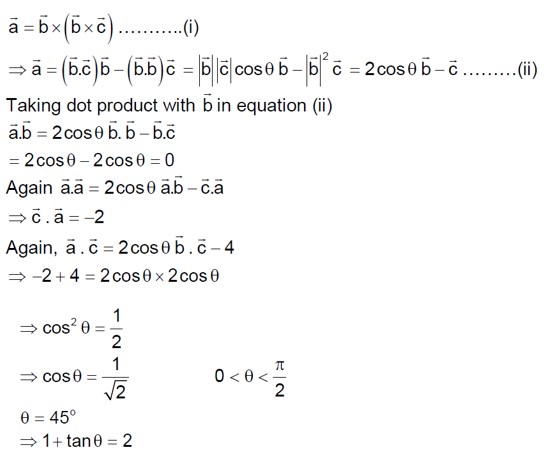Vector Algebra
Get insights from 133 questions on Vector Algebra, answered by students, alumni, and experts. You may also ask and answer any question you like about Vector Algebra
Follow Ask QuestionQuestions
Discussions
Active Users
Followers
New answer posted
2 months agoContributor-Level 10
? + b? = λ? c? (i)
b? + c? = λ? (ii)
Form (i) – (ii),
? – c? = λ? c? – λ?
(1 + λ? )? = (1 + λ? )c?
? ? and c? are non – collinear
⇒ 1 + λ? = 0, 1 + λ? = 0
λ? = λ? = -1
⇒? + b? + c? = 0
New answer posted
2 months agoContributor-Level 10
⇒3αβ−2αβ=−1
⇒2αβ=4⇒αβ=2 . (i)
b.c=10
⇒−3α−2β−α=10
⇒4α+2β=−10
⇒2α+β=−5 . (ii)
From (i) and (ii)
α=−1/2, α=−2
β=−4, β=−1
a=i−2j−k
b=3i−2j+2k
c=2i−2j+k
a. (b*c)=9
New answer posted
2 months agoContributor-Level 10
a = I + j – k
c = 2i – 3j + 2k
Now,
b x c = a
=> (i+j–k) (2i–3j+2k) = 0
=> 2 – 3 – 2 = 0
=> –3 = 0 (Not possible)
=> No possible value of b is possible.
New answer posted
2 months agoContributor-Level 10
The angle bisector a is parallel to λ ( b? +? ) or μ ( b? -? ).
b? = (i+j)/√2 and? = (i-j+4k)/√ (1+1+16) = (i-j+4k)/ (3√2).
Case 1: a = λ ( (i+j)/√2 + (i-j+4k)/ (3√2) )
a = λ/√2 * (3 (i+j) + (i-j+4k)/3 = λ/ (3√2) * (4i + 2j + 4k).
a is given as αi + 2j + βk.
Comparing the j-component: 2 = λ/ (3√2) * 2 ⇒ λ = 3√2.
So, a = 1 * (4i + 2j + 4k) = 4i + 2j + 4k.
Comparing with αi + 2j + βk, we get α = 4 and β = 4.
(The image has a second case that needs evaluation as well).
Case 2: a = μ ( b? -? )
a = μ/ (3√2) * (3 (i+j) - (i-j+4k) = μ/ (3√2) * (2i + 4j - 4k).
Comparing the j-component: 2 = μ/ (3√2) * 4 ⇒ 4μ
New answer posted
2 months agoContributor-Level 10
c = λ (a x b).
a = I + j - k
b = I + 2j + k
a x b = | I j k |
| 1 -1 |
| 1 2 1 |
= I (1 - (-2) - j (1 - (-1) + k (2-1) = 3i - 2j + k.
c = λ (3i - 2j + k).
Given c ⋅ (i + j + 3k) = 8.
λ (3i - 2j + k) ⋅ (i + j + 3k) = 8
λ (3 - 2 + 3) = 8 => 4λ = 8 => λ = 2.
c = 2 (a x b).
We need to find c ⋅ (a x b).
c ⋅ (a x b) = 2 (a x b) ⋅ (a x b) = 2|a x b|².
|a x b|² = 3² + (-2)² + 1² = 9 + 4 + 1 = 14.
So, c ⋅ (a x b) = 2 * 14 = 28.
New answer posted
2 months agoContributor-Level 10
Given r x a = b x r, which means r x a + r x b = 0, so r x (a+b) = 0.
This implies r is parallel to (a+b). So, r = λ (a+b).
a = I + 2j - 3k, b = 2i - 3j + 5k
a+b = 3i - j + 2k.
r = λ (3i - j + 2k).
Given r ⋅ (αi + 2j + k) = 3. The OCR is unclear, but the equation appears to be r ⋅ (αi + 2j + k) = 3. The solution works with r ⋅ (αi + 2j + k) = 3, but theOCR says r. (ai+2j+k). Let's assume it's α.
λ (3i - j + 2k) ⋅ (αi + 2j + k) = 3
λ (3α - 2 + 2) = 3 => λα = 1.
Given r ⋅ (2i + 5j - αk) = -1.
λ (3i - j + 2k) ⋅ (2i + 5j - αk) = -1
λ (6 - 5 - 2α) = -1 => λ (1 - 2α) = -1.
From λα = 1, α = 1/λ.
λ (1 - 2/λ) = -1 => λ
New question posted
2 months agoNew answer posted
2 months agoContributor-Level 10
Given vectors a? and b? such that |a? | = |b? | and a? ⋅ b? = 0 (they are orthogonal).
The problem implies |a? |=|b? |=1.
Let c? = a? + b? + a? x b?
To find the magnitude of c? , we calculate |c? |²:
|c? |² = c? ⋅ c? = (a? + b? + a? x b? ) ⋅ (a? + b? + a? x b? ).
This expands to |a? |² + |b? |² + |a? x b? |² because all other dot products are zero (e.g., a? ⋅ b? = 0, a? ⋅ (a? x b? ) = 0).
|a? x b? |² = (|a? |b? |sin (90°)² = |a? |²|b? |².
So, |c? |² = |a? |² + |b? |² + |a? |²|b? |² = 1² + 1² + 1²*1² = 3.
∴ |c? | = √3.
To find the angle θ between c? and a? , we compute their dot product:
c? ⋅ a? = (a? + b? + a
Taking an Exam? Selecting a College?
Get authentic answers from experts, students and alumni that you won't find anywhere else
Sign Up on ShikshaOn Shiksha, get access to
- 65k Colleges
- 1.2k Exams
- 679k Reviews
- 1800k Answers



